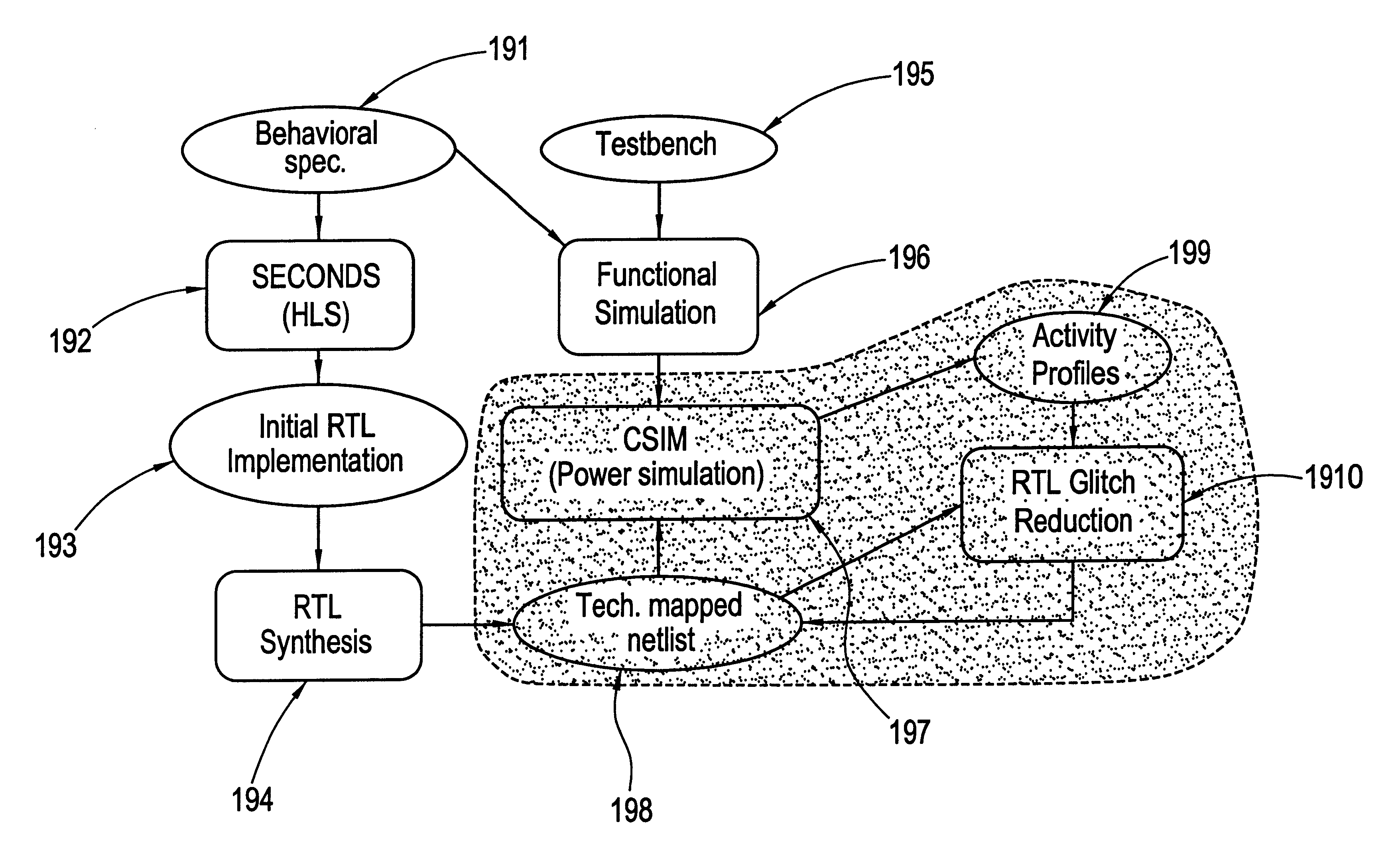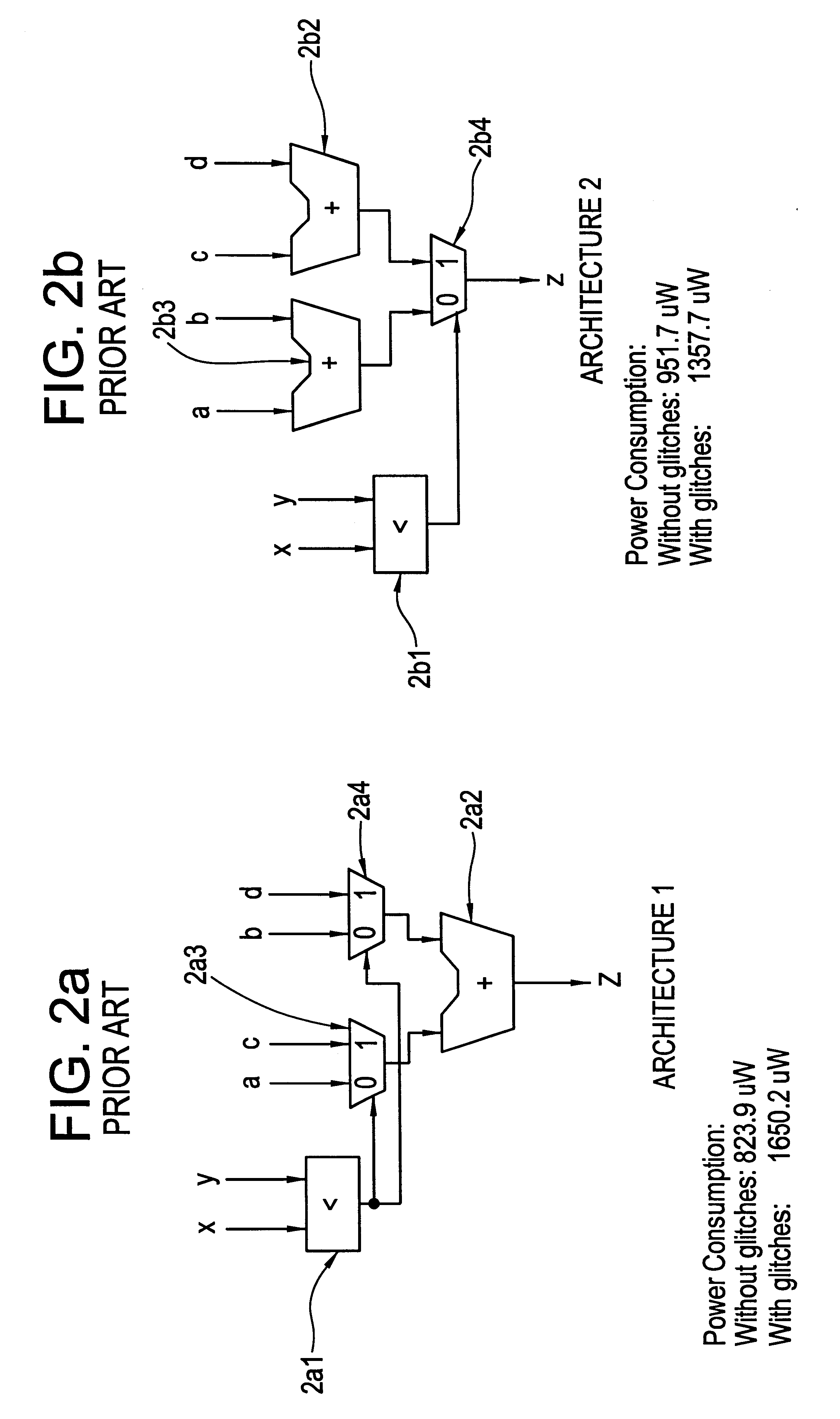Register transfer level power optimization with emphasis on glitch analysis and reduction
a technology of register transfer and power optimization, applied in pulse manipulation, pulse technique, instruments, etc., can solve the problems of increasing chip packaging and cooling costs, increasing the total system cost, and few automated design and synthesis techniques for reducing glitching power consumption in general circuits
- Summary
- Abstract
- Description
- Claims
- Application Information
AI Technical Summary
Benefits of technology
Problems solved by technology
Method used
Image
Examples
example 2
The elements shown in FIG. 3--a subtractor 31, an equal-to comparator 32, a less-than comparator 33 , and a 3-to-1 multiplexer tree 34 & 35--are representative data path blocks for studying glitch generation. The registers do not generate glitches at their outputs. To Study generation and propagation of glitches within above data path blocks, each block is mapped to a library like the NEC CMOS6 library, and then simulated under long input sequences that consist of random vectors. The total number of bit-transitions (including glitches) at the block outputs and the number of zero-delay transitions (i.e., the number of transitions not counting glitches) are measured. The block outputs in FIG. 3 are annotated with the results, where the numbers indicate transitions with and without glitches, respectively. The results clearly indicate significant generation of glitches in various data path blocks. In the equal-to comparator 32, no glitches are generated due to the fact that all its path...
example 3
Control signal contr[2] in the RTL circuit shown in FIG. 1 is highly glitchy according to the statistics of Table 2. The portion of the decode logic that implements this control signal is shown in FIG. 4(a). It has been observed that though the inputs are largely glitch-free, significant glitches are generated at AND gates G1 and G2. Careful analysis shows that the generation of glitches is attributable to two conditions:
C1: A rising transition on signal x1 is frequently accompanied by a falling transition on c11. Thus, the rising transition on x1 and the falling transition on c11 are highly correlated.
C2: Transitions on signal x1 arrive earlier than transitions on signal c11.
Condition C1 arises due to the functionality of the design: most of the times when state s is entered (rising transition on x1), the comparisons evaluated by the comparators feeding c9 and c10 evaluate to 0, changing from 1 in the previous state. On the other hand, condition C2 is a result of the delay / temporal...
example 4
This example uses a portion of an RTL circuit that is a processor for a barcode reader and the analysis focuses on a particular control signal, contr[1], whose implementation is given in FIG. 5. Signals state[2], state[1] and state[0] are fed by the flip-flops of the controller. Signals x3 and x4 represent decoded state signals, i.e., x3 (x4) assumes a logic value of 1 if and only if the controller is in state s3 (s4), or equivalently, state[2]. . . state[0] assume the values 011 (100). Signals x3, x4 and control signal 5 contr[1] are annotated with their transition counts including and excluding glitches. The figures indicate that the output of gate 5G5 is highly glitchy even though glitches do not occur at its inputs.
In order to explain the generation of glitches at gate 5G5, the partial state transition graph for the controller that is shown in FIG. 6(a) must be considered. The figure indicates a loop involving states s3 and s4. This results from a while loop in the VHDL behavior...
PUM
 Login to View More
Login to View More Abstract
Description
Claims
Application Information
 Login to View More
Login to View More - R&D
- Intellectual Property
- Life Sciences
- Materials
- Tech Scout
- Unparalleled Data Quality
- Higher Quality Content
- 60% Fewer Hallucinations
Browse by: Latest US Patents, China's latest patents, Technical Efficacy Thesaurus, Application Domain, Technology Topic, Popular Technical Reports.
© 2025 PatSnap. All rights reserved.Legal|Privacy policy|Modern Slavery Act Transparency Statement|Sitemap|About US| Contact US: help@patsnap.com



